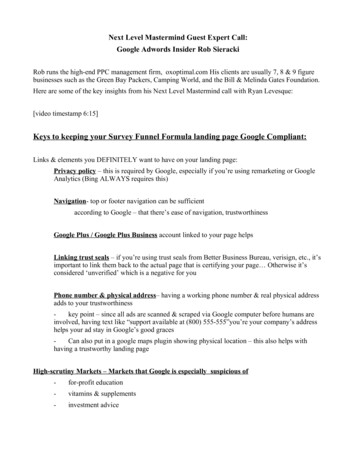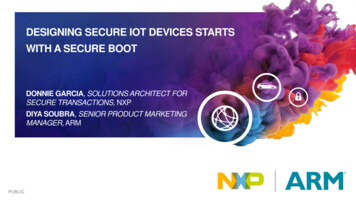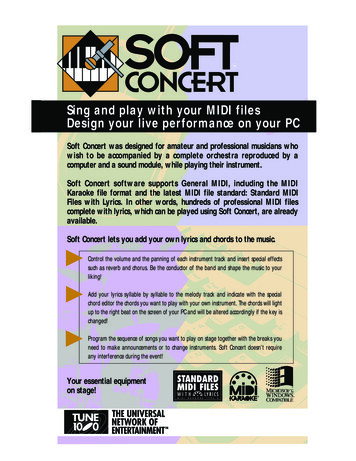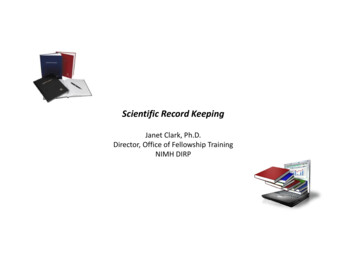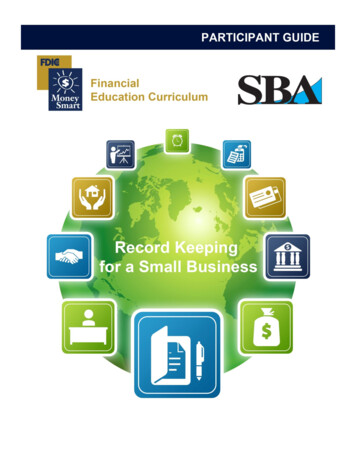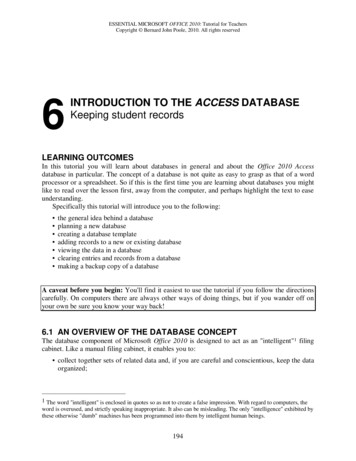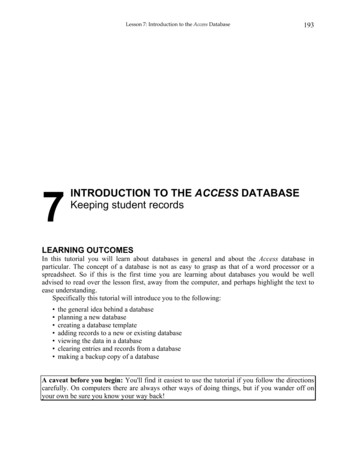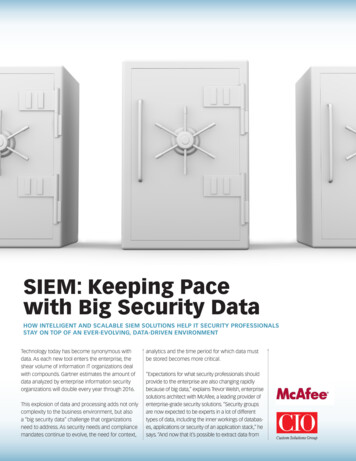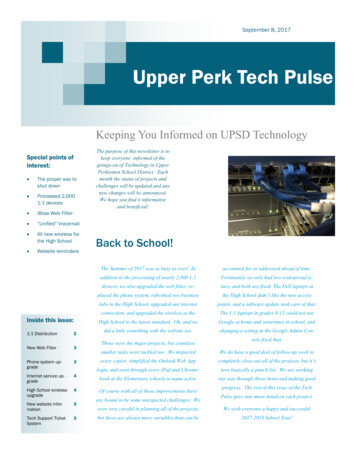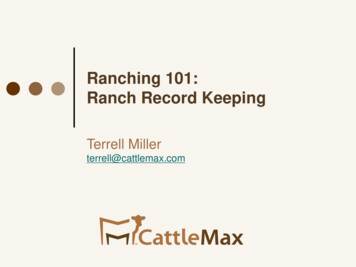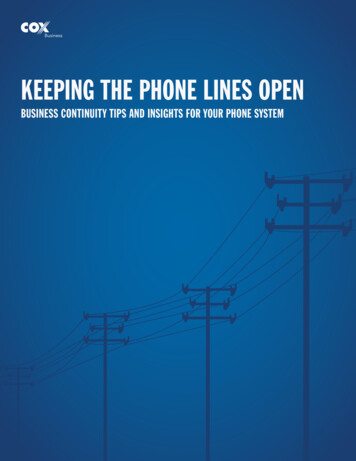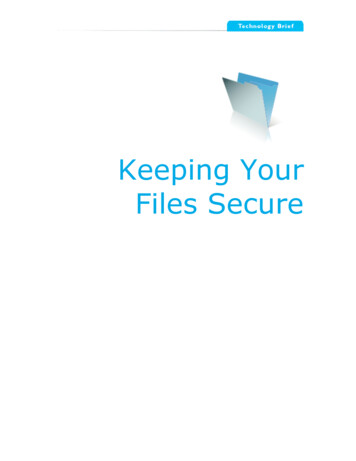
Transcription
Keeping YourFiles Secure
CONTENTSExecutive Summary .2A Broad View of Security .3Threats and Risks.4The FileMaker Security Architecture .5First line of Defence – Accounts and Privileges.7Supporting Considerations – Design for Security . 13Physical Security – Data and File Storage Strategies . 16Security in Practice – Ongoing Management . 19The Human Factor. 21Conclusions . 22Executive SummaryThe FileMaker product family supports industry standards and best practices forsecure data management. A mix of technologies and techniques is available tosupport secure configuration and deployment of FileMaker systems.As is the case with all modern data management systems, care must be taken toprotect the physical security of files containing sensitive data and/or valuableintellectual property. In doing so you minimize exposure to brute force assault orother methods for obtaining forced access to the contents of your files.FileMaker is notable for the degree of granular and dynamic control it provides overaccess to the content of database files. This includes the specification of multi-levelaccess to individual scripts, layouts (screens), value lists, data tables, records andfields. In the case of record access, an option for configuring data dependent accessto individual records is also available.Where feasible, the use of external (domain-level) authentication is recommended,and this is fully supported by FileMaker Server. Where this is not an option,additional measures (removal of admin access accounts) should be considered as anadjunct to other security.Techniques for automation of access control management and for enhancing the userinteraction model as it relates to the security architecture of FileMaker solutions arepresented. This includes provisions for a conventional login/logout process withouthaving to close your solution filesKeeping Your Files SecurePage 2
A number of additional technologies are available for use in conjunction withFileMaker’s native security configuration. This ranges from data encryption tobiometric authentication. However, careful consideration should be given to methodsof implementation to ensure that new vulnerabilities are not introduced.In addition, this paper includes practical advice for developers regardingconfiguration options and techniques, and proposes a strategic approach toidentification and amelioration of security threats.A Broad View of SecurityFileMaker database files contain at least three kinds of potentially sensitiveinformation, which might be characterised as: Structural/Concrete – the code and intellectual property associated with thesolution itself. Implicit – the business rules, procedures and processes that are embedded inthe code and interface. Explicit – the data, which may contain private, confidential or otherwiseprivileged information.If any of the above is of value or importance to you, or of a sensitive nature, thensafeguarding your data matters.“Safeguarding” is a broad term that acquires meaning once we are able to define thethreats, risks or contingencies that must be managed. Among them, are threats ofmalicious damage, misappropriation of code or information and inadvertentmodification or deletion of data.Keeping files secure is one of many facets to consider when managing potential risksand threats. However, it is not useful to consider it entirely in isolation. There islittle value in investing a great deal of effort and expense in security measures whileoverlooking other potential hazards and threats – eg to data integrity and applicationstability. Similarly, the benefits of application security are diminished if inadequateattention is given to physical security. A balanced approach is always desirable.There are some instances when the level of threat to security is moderate and wherethe consequences of a breach of security would not be far-reaching. Nevertheless,even for solutions that operate within a secure environment or include no overtlysensitive information, there is an investment (both in the data and in the solutionitself) to protect. In cases where security is added as an afterthought the levels ofrisk are needlessly high.FileMaker’s flexibility, from single use solutions to corporate systems, is supported bya powerful security capability that can be configured to provide a high degree ofgranularity over access to data. The security model can, in turn, be leveraged toprovide a number of benefits to the developer(s) and the owner(s) of the data.Along with other measures for the protection of critical data, security serves anumber of purposes. Security measures are principally concerned with: Who has access?Keeping Your Files SecurePage 3
Protection of the confidentiality of business data – meeting publicexpectations and statutory obligations regarding privacy – and safeguardingtrade secrets, intellectual property and other commercial-in-confidenceinformation. How data is accessed/used?A means for guiding and limiting the scope of action and interaction thatindividuals have with the application and the data it contains. This canprovide one of the keys to maintaining the integrity and validity both of dataand of the systems that store and support the data. The life-cycle of systems and data?Providing one of the principle mechanisms by which we are able to determinehow data will come into existence and how and when it will depart (eg bydeletion or archiving). This adds an important dimension to the quality of thedata while also ensuring its survival to meet ongoing needs.This is the “who, how, when and where” of data and system use. When you are ableto control and manage these factors, the fate of your data – and the business thatdepends on it – will be greatly improved.Threats and RisksThere are many different ways that data and files can come under threat. A careless user A poorly written and tested script An unscrupulous business competitor An underworld hackerThreats can range from a simple action to a real or imagined threat. In fact, thedramatic images of the secret operative stealing company information or a hackerintercepting corporate secrets remotely can distract attention from the fact that mostrisks and threats are considerably more mundane.If data or proprietary code is going to leave your premises without your permission,it is as likely to do so as a result of a petty break and enter or an innocent humanerror as by more insidious means. Network encryption and 24-hour security watchwill not help at all if there are passwords written on sticky notes throughout theoffice. Moreover, system failures are caused by a hot cup of coffee being spilled intothe database server just as surely as they are caused by cyber vandals or corporatesaboteurs. It is worth considering the range of possible hazards, their magnitudeand their likely consequences, in order to respond with a mix of measures which willadd up to a reasoned response to the assessed risks.As part of a balanced perspective, keep in mind that by nature security is a matter ofdegree and not of absolutes. We can take measures to increase the difficulty withwhich unauthorised access to a system can be gained but we cannot achieveabsolute certainty that any measures we set in place will not be breached. Even withan unlimited budget, security cannot be absolutely guaranteed.Keeping Your Files SecurePage 4
One response to this lack of certainty is to consider the motives of those who mightbreach security measures and to measure the response accordingly. This provides areasonable framework within which to make a judgement about how much security isenough.The ever-present motive for poor security is human inertia. A lack of care orvigilance leads to Poor choices and errors Data being written into the wrong fields Printouts left lying around Passwords being sharedand so on.To address the potential issues it is necessary to design systems that make it easierto do things the right way than to do them the wrong way. Staff who are required touse a dozen different passwords will write them all on pieces of paper on their desk.Give them a single sign-on and the problem disappears. If the data entry screens donot match the stationery information comes in on you run the risk of sensitive dataending up in the wrong fields. However, if you provide a good match betweenscreen layouts and forms the problem will be greatly reduced.There are, of course, a few more motives for breaches of security that are associatedwith darker human emotions such as greed, envy and, revenge. Most of thesemotives have a price attached – so the effort and expense likely to be expendeddefeating security measures is apt to be roughly proportional to the anticipatedgains. If you are able to increase the apparent level of difficulty of defeating yoursecurity to the point where the cost is greater than any benefits then most will bedeterred from even trying.FileMaker Pro provides versatile and robust security options that can offer levels ofsecurity that will withstand any casual intrusion and that provide a level of protectionagainst more purposeful attacks. It is the purpose of this paper to outline the coretechnologies of FileMaker security and to propose deployment and configurationchoices to best suit a range of situations and requirements.The FileMaker Security ArchitectureFileMaker Inc offers a suite of products that can be configured to suit a wide range ofneeds. Because of this, there are some challenges when it comes to describingoptimal security measures. What might be appropriate for a stand-alone single-usersolution is not necessarily well suited for a server or web-based deployment – andvice versa.There is also the question of the protection of Intellectual Property (IP) rights in thecode and interface of the solution. While there is some overlap between themechanisms that support these twin aspects, the methods of dealing with them aredifferent.When a FileMaker file is first created, it is essentially, empty. Aside from a defaulttable and a blank layout, a new file contains two user accounts and three defaultKeeping Your Files SecurePage 5
privilege sets. These parts of a file are sufficient to start development of a solution,including developing an appropriate security infrastructure for the file.From the standpoint of FileMaker solution architecture, several technologies providethe core elements of solution security 1. The authentication and access control system, with its control of access andprivileges at a granular (table, record and field) level within each file. Accesscontrol is flexible enough to provide configuration options for both contentand structural elements of a file2. The availability of Secure Socket Layer (SSL) encoding of network datastreams when files are made available using FileMaker Server or FileMakerServer Advanced. Network encryption offers a form of protection to accesscontrol for solutions that is made available to users of FileMaker Server overLAN or WAN connections. The additional privacy this affords makes remoteconnections (using the native FileMaker networking capabilities) a reasonableoption in some cases depending on the available bandwidth. It is extremelystraightforward to implement, requiring only that the relevant option beenabled in the configuration of an installation of FileMaker Server. This can beaccomplished within the interface provided by the FileMaker Server Admintool (SAT), by selecting the configuration icon for “Security” and steppingthrough the options presented.While the interface of the SAT differs between Windows and Macintoshinstallations, many of the configurable options are the same. In both cases,after selecting to enable (or disable) secure connections, it is necessary torestart FileMaker Server. Once this is done, industry standard SSL encryptionwill be seamlessly applied to incoming and outgoing communications with theServer.3. The ability to set up FileMaker access accounts which will be authenticated atthe domain level against a server running Active Directory or OpenDirectory.The configuration of this option, and the considerations, benefits and cautionsfor its use warrant careful consideration and so are discussed in greater detailin the section headed “Physical Security – Data and File Storage Strategies”(below).4. The capability to remove [Full Access] accounts / access for a file or solutionusing the Developer Utilities of FileMaker Pro Advanced. This feature is oftenassociated with runtime applications. There are circumstances in whichconsideration should be given to its use for served or conventionally accessed(i.e. using FileMaker Pro client application) local files. This will be explored indetail below.While discussing the security architecture of FileMaker, it is appropriate to give someconsideration also to the methods used for internal authentication, in particular thestorage and use of passwords.All FileMaker’s internal security capabilities are file-based and therefore must becreated and maintained within each file. If passwords (for internal authentication)exist, they must be separately specified and maintained within each file.FileMaker does not store passwords per se – instead they are stored as a hash. Ahash can best be described as a lengthy and sophisticated checksum that has beenKeeping Your Files SecurePage 6
generated from the original password. When authentication is occurring, achecksum is generated from the supplied password and is compared to the storedpassword hash value for the relevant account. If they match, it is assumed that thepassword was correct and access is granted. A key characteristic of this approach isthat it is not possible to reconstruct the password from the hash value – its originalform is lost during the process that derives the hash.This system of password authentication has both advantages and disadvantages.Because the password required for file access is not stored – not even in anencrypted state – one avenue for attack against the security system is closed. Thismay be viewed as a benefit in the sense that the security system is robust – or as adisadvantage if all passwords are lost by their legitimate owners, since there is nodirect route to regain access to the files.It is important to note that techniques and tools exist that are capable of forcingpassage past the native security. These tools accomplish this by overwriting thedata blocks within a file that contain password verification bits (the hash data) withbogus hash data associated with known password strings. Since these tools aredistributed by third parties, their quality may vary and in some cases may causedamage to the files themselves. While such tools might be used to restore access toa file for its legitimate owners, they are also open to abuse and may be employed togain unauthorized access to data or the IP embedded in a solution. No greaterclarity can be given to the truth that absolute security cannot be guaranteed.However, it should be remembered that FileMaker Pro is no different from othercontemporary software tools and that equivalent threats to security exist for them aswell. It is one of the ever-present realities of information management.First line of Defence – Accounts and PrivilegesFileMaker’s model for user access control depends on a versatile structure for userand account management. At the heart of this structure is the concept of thePrivilege Set. A Privilege Set represents a comprehensive definition of access that anindividual or group of individuals have to data and functionality throughout thedatabase file.Privilege Sets are defined within the file and are specific to the file. They provide theability to create granular controls over the behaviour and accessibility of individualelements down to the record and field level within the schema and to the level ofindividual scripts, value lists and layouts.Privilege Sets also collect together a set of operational capabilities, and provide themas a group to a number of individuals whose roles and usage requirements will besimilar. in other words, privilege Sets provide a mechanism to aggregate users intogroups and provide them with similar access. Similarly, Privilege Sets furnish themeans to aggregate a variety of controls representing the functional and structuralelements of a particular database file.These twin “aggregating actions” of the Privilege Set provide the basis of what issometimes referred to as “role based” security. Role based security operates on theidea of customized access configurations that can be made available to categories ofusers according to the role they perform and the kinds of interaction with thedatabase which will be appropriate to their needs. Thus in a given database, Clerksmight require data entry access to certain tables, Accountants might require accessto the reports and audit components, while the Department Research Officer mayKeeping Your Files SecurePage 7
desire read-only access to the system. Such a situation would be served by thecreation of three separate Privilege Sets within the databases, each reflecting theneeds of one of the groups of users.Figure 1 – Privilege Sets defined to reflect user roles.The creation of multiple Privilege sets is done from the Privilege Sets tab of theManage Accounts & Privileges dialog — which is accessible from the Managesubmenu on the File menu. Figure 1 (above) shows the configuration windowdisplaying an overview of Privilege Sets in line with the example in the previousparagraph.The definition of access for each privilege set is defined within the “Edit Privilege Set”dialog (which can be accessed by selecting a line within the Privilege Sets tab shownat Figure 1). The Edit Privilege Set dialog provides a high level overview of theaccess control attributes that have been assigned to the Set. On the right, a numberof generic privileges are displayed – these control actions for the whole file, includingmenu, printing, export and password change controls.At the upper left of the Edit Privilege Set dialog (see Figure 2), drop-down menus areprovided for the specification of access to data (Records), Layouts, Value Lists andScripts. The simplicity of the interface shown in this dialog hides the granularcomplexity that is available as we drill down to a further level.Keeping Your Files SecurePage 8
Figure 2 – The Overview of access controls for a Privilege Set.For each of the four categories of access represented by the drop-down menus, three(or in the case of Records, four) generic options are provided. For two of the fouraccess categories the generic options are: All modifiable All view only All no accessAnd for the Records access control, the “All modifiable” option is further sub-divided,as shown at Figure 3, to provide editing capabilities either with or without the abilityto delete records. The wording on this menu is extended to make it clear that anoption selected at this level will apply equally to all tables within the file. As such,the generic options will be suitable in some situations. However if the genericoptions do not meet your requirements or needs, it may be necessary to select theseparated option at the bottom of the list, which is labelled “Custom privileges ”.Figure 3 – Generic options for data access.The custom privileges options on each of the four d
restart FileMaker Server. Once this is done, industry standard SSL encryption will be seamlessly applied to incoming and outgoing communications with the Server. 3. The ability to set up FileMaker access accounts which will be authenticate
